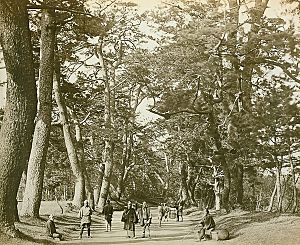Tōkaidō (road) facts for kids
The Tōkaidō (東海道, East Sea Road) was a very important road in ancient Japan. It was one of the five main roads during the Edo period (a time when Japan was ruled by shoguns). This famous road connected Edo (which is now modern-day Tokyo) and Kyoto. It followed the beautiful sea coast of eastern Honshū, the largest island in Japan.

Traveling the Tōkaidō Road
Along the Tōkaidō road, there were fifty-three special stops called shuku-eki (waystations). The Shogun's government kept these stations running smoothly. They were like rest stops or small towns where travelers could find food, lodging, and fresh horses.
Most people traveled the Tōkaidō on foot. It was a long journey, so these waystations were very important for travelers to rest and get ready for the next part of their trip.
Art and the Tōkaidō
The Tōkaidō road was so famous that it inspired many artists. One of the most well-known art series about the road is The Fifty-three Stations of the Tōkaidō. This series of woodblock prints was created by a famous Japanese artist named Hiroshige. His prints show the different landscapes and scenes at each of the fifty-three stations.

Modern Tōkaidō
Even today, the Tōkaidō name is used for important routes in Japan. For example, the Tōkaidō Shinkansen is a very fast bullet train line that connects Tokyo and Kyoto, following a path similar to the old road. There is also a Tōkaidō (region) which refers to the geographic area along the historic route.
Images for kids
-
Nissaka Station, Utagawa Kuniyoshi, Tōkaidō gojūsan tsui . Collection Samuel P. Harn Museum of Art (2005.25.7.26) Samuel P. Harn Museum of Art
See also
 In Spanish: Carretera Tōkaidō para niños
In Spanish: Carretera Tōkaidō para niños




